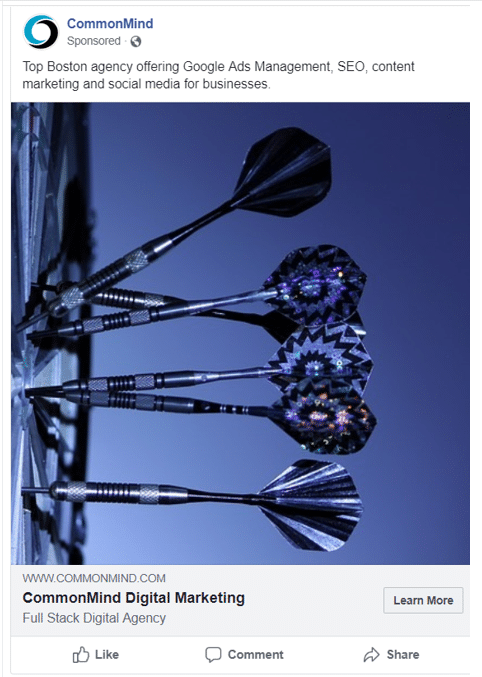Why Are Your Brand CPCs Getting More Expensive?
So, what’s causing this trend? Some recent changes to the AdWords algorithm, combined with higher competition in the paid search space, caused search CPCs to increase by 21% in 2017 vs. 2016 (an all-time high).
In a sampling of CommonMind clients, results were varied. We saw no marked increase in exact match brand CPCs from 2016 to 2017 in four of the six accounts we reviewed. However, one account saw a 110% YoY increase in the brand CPC. In the past month (January 2018), three out of the six campaigns we evaluated for YoY changes (2016 vs. 2017) have seen marked increases in their brand CPC ranging from 36% to 172%.
We took a closer look at some overall trends versus changes specific to Google, to help us unpack exactly what may be contributing to rising CPCs for brand terms. We also identified opportunities for achieving marketing goals based on the latest trends.
Digital advertising is getting more expensive and competitive
In 2017, the U.S. spending on digital was projected to reach 83 million dollars, surpassing TV advertising for the first time ever. This is an increase of about 16% over the previous year.
Though 2017 Q4 totals are not in yet, most of that revenue will go to Google (42%) and Facebook (21%) as predicted by eMarketer. Competition to dominate search results is fierce, which translates into higher YoY CPCs and higher acquisition costs even for brand terms.
iProspect’s Q4 2017 Quarterly Paid Search Report, several new industry trends are contributing to rising CPCs, including a decline in desktop impressions, which are falling faster than mobile impressions are growing, and Amazon’s growing role in search via the introduction of the Amazon Echo which was first released at the end of 2014.
YoY CPCs are Increasing Across All Devices and Platforms
iProspect’s Q3 2017 Paid Search Trends Report, released in October 2017, showed that while generic CPCs declined by 4% in Q3 compared to Q2, year-over-year CPCs increased by 27% overall for Google.
By network and device, CPCs increased as follows:
- +28% all devices
- +31% search
- +15% shopping
- +28% desktop
- +32% mobile
- +22% tablet
iProspect recorded YoY impression and click declines of 9% and 23%, respectively, with the steep drop in clicks a result of higher CPCs. This drove less traffic for each dollar spent.
Mobile was a contributing factor in the overall increase in CPCs, up 32% YoY. It hit an all-time high in Q2 2017, though it dropped by 7% in Q3 2017.
It’s Google’s Fault
In February of 2016, Google eliminated right rail ads from its paid search results. This reduced the available ad inventory to four key ad placements directly below the search box. While this boosted CTR for the top four ads (collectively) by 49% according to a study by UK-based agency Accuracast, it also increased competition.
Additionally, Search Engine Land attributes the rising cost of brand CPCs not only to mobile search competition, but to Google’s May 2017 update. The May update reprioritized keyword bids over other factors such as quality score (in some contexts). At the same time, Google changed the way they display exact match keywords, allowing close variants (e.g., plurals, typos, abbreviations, adverbs, etc.) of these keywords to appear for exact match queries.
Google also removed the 30% cap for enhanced CPC (ECPC) bidding for location and audience. This means Google can increase the maximum bid amount (specified by you) to a much higher bid amount. Here is Google’s explanation of ECPC:
“ECPC works by automatically adjusting your manual bids for clicks that seem more or less likely to lead to a sale or conversion on your website. ECPC looks for ad auctions that are more likely to lead to conversions, and then raises your max CPC bid (after applying any bid adjustments you’ve set) to compete harder for those clicks. If a click seems less likely to convert, AdWords will lower your bid.”
This change aims to increase conversions by increasing bids where users are more likely to convert, but this has obvious implications for driving up CPCs as well.
Internet Adoption Has Flatlined
For the past several years, U.S. internet adoption has slowed and remained flat. This is contributing to fewer search impressions overall. According to a study by Adobe Digital Insights (ADI), visits to U.S. websites have declined by 0.4% over the last three years while the cost of digital advertising is up 12% across all channels, rising five times faster than inflation.
Search has been hit particularly hard. ADI’s analysis reports that while search spend has increased by 42%, site visits have only increased by 11%, and those paid visitors aren’t staying as long, with the average time on site down 22 seconds (-6% YoY).
Opportunities
There are still many opportunities to target your customers online via a variety of tactics, including paid search.
While search and social ads continue to cost advertisers more money with declining rates of return, digital video growth is exploding. Adobe reports that video plays on TV Everywhere (TVE), which allows cable subscribers to watch streaming video on smartphones, tablets, and connected devices, has grown by 102% over the last two years. Users of TVE have increased 110%. Investing in quality video content and promoting this content on YouTube and other video channels provides an opportunity for advertisers who want to reach this growing audience.
Invest (or continue to invest) in Remarketing. Remarketing (also called retargeting) is available for search and display ads in AdWords. These are two effective strategies for hyper-targeting people who have visited your website in the past or expressed interest in your product. While ad inventory is more limited for this kind of targeting, response rates (and ROI) are much higher.
Wordstream reports that remarketing conversion rates increase over time with the frequency they see the ad (even though CTRs actually decrease over time). Facebook and Google’s Display Network have the largest reach, over 90% of worldwide Internet users. In fact, thanks to remarketing, display ads convert almost as well as search ads (and even better in some industries).
With traditional search ads delivering a less favorable ROI due to rising CPCs, Wordstream’s founder, Larry Kim, has even suggested focusing exclusively on remarketing. In Search, this would mean only showing ads to users who have already visited your website. If you have a robust remarketing list, this is certainly a strategy to consider. The challenge for many advertisers remains, however: how do they get users to their website for the first time so they build bigger and bigger remarketing lists?
Be vigilant.
Keyword search will continue to be an important part of your digital strategy throughout 2018 and beyond, but it’s more crucial than ever to keep up to date with the latest changes to AdWords and with online trends that are increasingly influencing how people search for information. It is important to monitor your keyword CPCs on a regular basis, continue optimizing your account for quality, and make sure you’re leveraging features like remarketing for search, ad extensions, and device-specific bid modifiers to ensure you’re reaching the right searchers as efficiently as possible.
Build the Brand
Beyond the Search channel, look for new ways to drive interest in your brand, including with video. CPCs across the board are rising in Search, but CPCs for branded terms and remarketing still provide better value and ROI than advertising non-branded search terms to users who have never heard of you.
Get users to be familiar with your brand by leveraging the incredible reach of Google’s Display Network, YouTube, and Facebook to build your remarketing lists, and you’ll gain an advantage over your competitors.
If you have any questions about how these trends are impacting your marketing performance or which opportunities might be the most appropriate for your brand, please reach out to someone at CommonMind, and we’ll be happy to help.
Share this
You May Also Like
These Related Stories

Twenty Examples of Digital Marketing Ads
